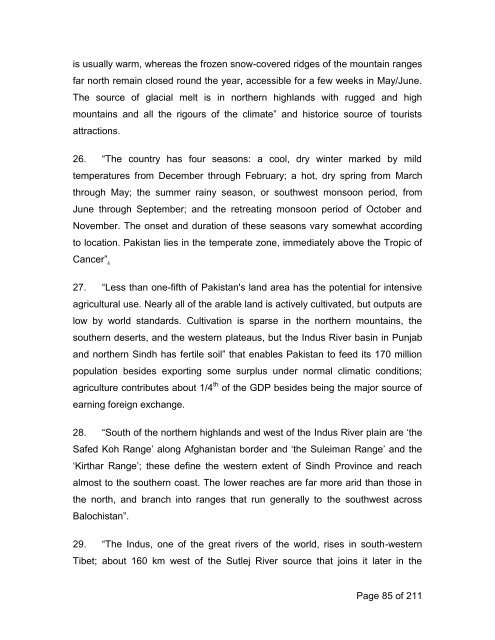Khawaja Zaheer Ahmed - PDMA
Khawaja Zaheer Ahmed - PDMA
Khawaja Zaheer Ahmed - PDMA
Create successful ePaper yourself
Turn your PDF publications into a flip-book with our unique Google optimized e-Paper software.
is usually warm, whereas the frozen snow-covered ridges of the mountain ranges<br />
far north remain closed round the year, accessible for a few weeks in May/June.<br />
The source of glacial melt is in northern highlands with rugged and high<br />
mountains and all the rigours of the climate” and historice source of tourists<br />
attractions.<br />
26. “The country has four seasons: a cool, dry winter marked by mild<br />
temperatures from December through February; a hot, dry spring from March<br />
through May; the summer rainy season, or southwest monsoon period, from<br />
June through September; and the retreating monsoon period of October and<br />
November. The onset and duration of these seasons vary somewhat according<br />
to location. Pakistan lies in the temperate zone, immediately above the Tropic of<br />
Cancer”.<br />
27. “Less than one-fifth of Pakistan's land area has the potential for intensive<br />
agricultural use. Nearly all of the arable land is actively cultivated, but outputs are<br />
low by world standards. Cultivation is sparse in the northern mountains, the<br />
southern deserts, and the western plateaus, but the Indus River basin in Punjab<br />
and northern Sindh has fertile soil” that enables Pakistan to feed its 170 million<br />
population besides exporting some surplus under normal climatic conditions;<br />
agriculture contributes about 1/4 th of the GDP besides being the major source of<br />
earning foreign exchange.<br />
28. “South of the northern highlands and west of the Indus River plain are ‘the<br />
Safed Koh Range’ along Afghanistan border and ‘the Suleiman Range’ and the<br />
‘Kirthar Range’; these define the western extent of Sindh Province and reach<br />
almost to the southern coast. The lower reaches are far more arid than those in<br />
the north, and branch into ranges that run generally to the southwest across<br />
Balochistan”.<br />
29. “The Indus, one of the great rivers of the world, rises in south-western<br />
Tibet; about 160 km west of the Sutlej River source that joins it later in the<br />
Page 85 of 211


